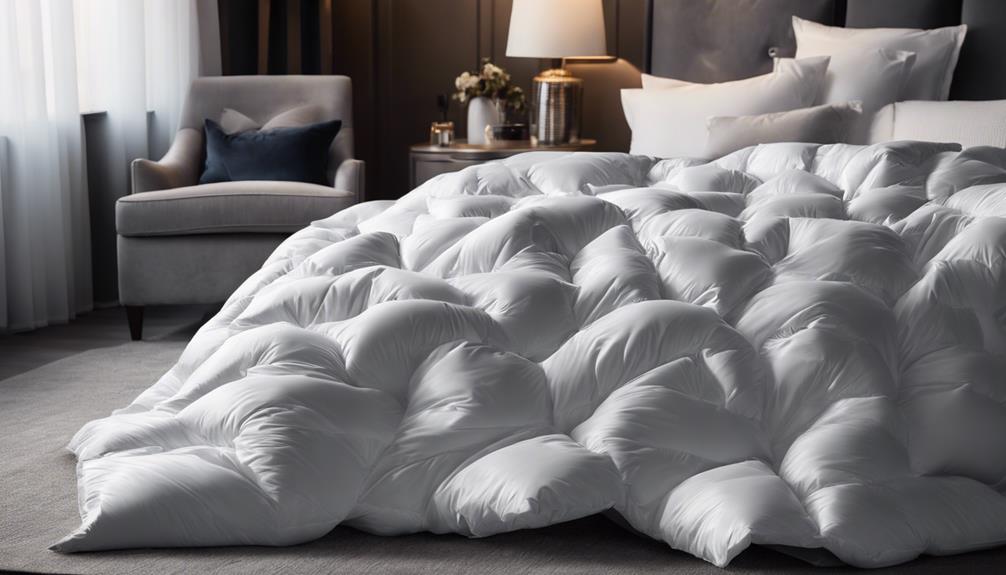Down comforters are not filled with feathers; they instead contain the soft undercoating of geese or ducks known as down. Down’s unique three-dimensional structure offers exceptional insulation and comfort, making it superior to feathers which are heavier and less insulating. To prevent any feather leakage, it’s important to consider factors such as thread count, fill power, and quality construction. Proper maintenance, including using a duvet cover and following proper cleaning techniques, can help extend the lifespan of your comforter. When selecting a down comforter, opt for one with a fill power of 600 or higher and quality stitching from a reputable brand for maximum loftiness. Gain valuable insights on down comforters!
Key Takeaways
- Down comforters are filled with soft undercoating from geese or ducks, not feathers.
- Down clusters lack quill shaft and fibers, differentiating them from feathers.
- Feathers are heavier and provide less insulation compared to down.
- Quality down comforters have a fill power of 600 or higher for superior loftiness.
- Opt for down comforters filled with soft undercoating and check for quality stitching.
Composition of Down Comforters
In crafting down comforters, we exclusively use the soft undercoating of geese or ducks, known as down, for its superior insulation and plush feel. Down comforters are filled with down clusters, which lack the hard quill shaft and fibers found in feathers. These down clusters resemble three-dimensional dandelion pods, providing exceptional insulation properties. The fill power of down, which measures its fluffiness and insulating ability, determines the quality of the comforter. Feathers, on the other hand, have a quill shaft and fibers, making them unsuitable for down comforters.
Thanks to the absence of feathers in the fill, down comforters are lightweight yet luxurious, offering a cozy sleep experience. The composition of down comforters ensures a plush and airy feel, enhancing comfort during colder nights. This unique construction of down clusters contributes to the warmth and coziness of the comforter, making it a popular choice for those seeking a comfortable and restful sleep environment.
Understanding Down and Feathers

Understanding the distinction between down and feathers is essential for appreciating the unique qualities of down comforters. Down, the soft under plumage of geese or ducks, is known for its exceptional softness, durability, and insulating power.
In contrast, feathers are the outer plumage of these birds, which are heavier and provide less insulation compared to down. The fill power of down comforters, ranging from low to high, determines their quality. Lower fill power allows for more airflow, making the comforter lighter and suitable for warmer climates.
On the other hand, higher fill power traps more heat, offering increased warmth for colder environments. Down comforters, made from these natural materials, provide excellent insulation while remaining breathable to prevent overheating.
This combination of natural fibers results in a luxurious and comfortable bedding option that's both cozy and light.
Potential Feather Leakage

Feather leakage can be a common concern with down comforters, especially if the stitching and overall construction aren't of high quality. When considering potential feather leakage in down comforters, several factors play an important role:
- Thread Count: The fabric's thread count influences how well the comforter retains its feather filling. Higher thread counts typically result in better containment of feathers.
- Fill Power: The fill power of the down affects the loft and insulation of the comforter. Higher fill power often correlates with better quality and reduced feather leakage.
- Construction Quality: Tight stitching and high-quality construction are essential in preventing feather leakage. Well-constructed comforters are less likely to experience feathers escaping over time.
- Maintenance: Proper maintenance practices, such as gentle washing techniques, are crucial in preserving the integrity of the comforter and minimizing feather loss.
Maintenance Tips for Down Comforters

Utilizing a duvet cover is a practical strategy to safeguard your down comforter from potential feather leakage caused by sudden movements or spills. To maintain your bedding in top condition, consider the following maintenance tips:
| Maintenance Tips for Down Comforters | |
|---|---|
| Bedding | Use a duvet cover to protect against feather dispersal. |
| Fill Weight | Avoid sitting on the comforter for extended periods. |
| Fill Power | Opt for dry-cleaning or commercial washers. |
| Feathers | Proper drying techniques help prevent feather loss. |
Choosing Quality Down Comforters

When selecting a quality down comforter, consider the fill power to guarantee maximum loftiness and insulation. High fill power indicates better warmth retention and a softer, fluffier feel.
Here are four key factors to keep in mind when choosing a high-quality down comforter:
- Fill Power: Look for a down comforter with a fill power of 600 or higher for superior loftiness and warmth.
- Material: Opt for down comforters filled with the soft undercoating of geese or ducks, not feathers, for a luxurious feel.
- Construction: Check for quality stitching to prevent the down from shifting and ensure even distribution for consistent warmth.
- Brand Reputation: Invest in a reputable brand known for producing high-quality bedding material to guarantee durability and comfort.
Frequently Asked Questions
Are All Down Comforters Made With Feathers?
Not all down comforters contain feathers. Pure down comforters are made solely from the soft undercoating of geese or ducks. Some may have a small percentage of feathers for added support. Feather fillings differ from down and affect the comforter's feel and performance.
Pure down comforters are lightweight, fluffy, and luxurious without feather stiffness. Consumers choose between pure down or blends based on softness and support preferences.
What Is the Difference Between Down and Feathers?
Down and feathers differ in their structure and qualities. Down is the soft, fluffy material found beneath feathers, offering superior insulation and warmth.
Feathers, on the other hand, have quills and lack the softness and flexibility of down. Down is lighter, fluffier, and more breathable compared to feathers.
Hungarian goose down, known for its high fill power, is luxurious in quality when compared to feathers.
What Is the Difference Between Goose Feather and Down Comforter?
We prefer down comforters as they contain the soft undercoating beneath feathers, ensuring superior warmth and comfort.
In contrast, goose feather comforters utilize the larger, stiffer outer feathers lacking the insulation and softness of down.
Opting for a down comforter guarantees a lighter, fluffier, and more resilient bedding experience with its flexible plumules.
The choice is clear for a softer, warmer, and more luxurious sleep.
Are Down Comforters Bad for Allergies?
When it comes to allergies, down comforters can be tricky. Dust mites and mold can build up in unwashed down, causing issues for some.
To combat this, regular washing helps. Hypoallergenic down or down alternatives are safer choices.
Adding duvet covers and pillow protectors can also shield against allergens. For severe allergies, consulting an allergist or opting for synthetic bedding is wise.
It's all about creating a clean, cozy sleep environment.
Do Down Comforters Shed Feathers When Covered?
Yes, covering options for down comforters can help prevent feathers from shedding. By using a duvet cover or other protective covering, you can keep the feathers contained and prevent them from escaping. This also helps prolong the life of your down comforter and keeps it looking clean and fresh.
Conclusion
To sum up, down comforters are typically made with a combination of down and feathers. While down provides the fluffy insulation, feathers add structure and support. However, it's important to note that higher quality down comforters will have minimal feather leakage.
For example, Sarah purchased a premium down comforter and after a year of use, she noticed no feathers coming out, showcasing the importance of investing in a quality product.
Remember to follow maintenance tips to prolong the lifespan of your down comforter.










